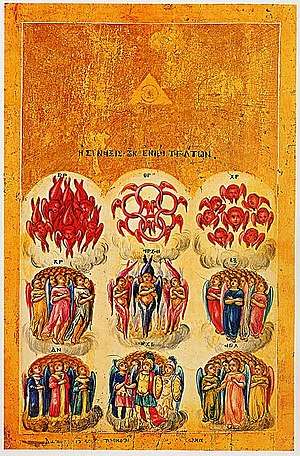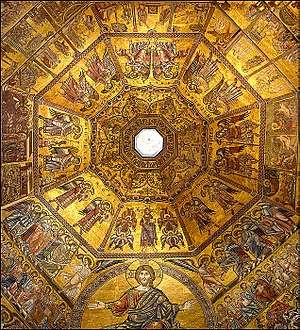Hierarchy of angels
A hierarchy of angels is a belief or tradition found in the angelology of different religions, which holds that there are different levels or ranks of angels. Higher ranks may be asserted to have greater power or authority over lower ranks, and with different ranks having differences in appearance, such as varying numbers of wings or faces.



Abrahamic faiths
Judaism
The Jewish angelic hierarchy is established in the Hebrew Bible, Talmud, Rabbinic literature, and traditional Jewish liturgy. They are categorized in different hierarchies proposed by various theologians. For example, Maimonides, in his Mishneh Torah or Yad ha-Chazakah: Yesodei ha-Torah, counts ten ranks of angels.
Christianity
The most influential Christian angelic hierarchy was that put forward by Pseudo-Dionysius the Areopagite in the 5th or 6th century in his book De Coelesti Hierarchia (On the Celestial Hierarchy). Dionysius described nine levels of spiritual beings which he grouped into three orders:[1][2]
- Highest order
- Middle order
- Dominions
- Virtues
- Powers
- Lowest order
- Principalities
- Archangels
- Angels
During the Middle Ages, various schemes were proposed, some drawing on and expanding on Pseudo-Dionysius, others suggesting completely different classifications.
Pseudo-Dionysius (On the Celestial Hierarchy) and Thomas Aquinas (Summa Theologiae) drew on passages from the New Testament, specifically Ephesians 1:21 and Colossians 1:16, to develop a schema of three Hierarchies, Spheres or Triads of angels, with each Hierarchy containing three Orders or Choirs.
Islam
There is no standard hierarchical organization in Islam that parallels the Christian division into different "choirs" or spheres, and the topic is not directly addressed in the Quran. However, it is clear that there is a set order or hierarchy that exists between angels, defined by the assigned jobs and various tasks to which angels are commanded by God. Some scholars suggest that Islamic angels can be grouped into fourteen categories, with some of the higher orders being considered archangels. Qazwini describes an angelic hierarchy in his Aja'ib al-makhluqat with Ruh on the head of all angels, surrounded by the four archangelic cherubim. Below them are the seven angels of the seven heavens.[3]
Zoroastrian
There is also an informal Zoroastrian angelic hierarchy, with the specific angelic beings called yazatas having key positions in the day-name dedications on the Zoroastrian calendar segregated into the ameshaspentas (the second to seventh of the 30 days of the month), yazatas and minoos (the last six of the 30 days of the month).
Role-playing games
Angels are occasionally presented in role-playing games as having ordered hierarchies, within which higher level angels have more power and the ability to cast more spells or exercise other magical abilities. For example, Angels in Dungeons & Dragons, a subgroup of the beings called Celestials, come in three different types, the progressively more powerful Astral Deva, Planetar, and Solar.[4][5] Another game which has summonable angels is Shin Megami Tensei, often classified under Divine, or Heralds. In the game series Bayonetta angels are enemies and all 3 spheres are present, each divided in the same 3 orders as the traditional hierarchy.
See also
- Christian demonology
- De Coelesti Hierarchia
- Hierarchy of demons
- Living creatures (Bible)
References
- Chase, Steven (2002). Angelic spirituality. p. 264. ISBN 978-0-8091-3948-4.
- McInerny, Ralph M. (1998). Selected writings of Thomas Aquinas. p. 841. ISBN 978-0-14-043632-7.
- Mehdi Amin Razavi Aminrazavi, Seyyed Hossein Nasr The Islamic Intellectual Tradition in Persia Routledge, 16.12.2013 ISBN 9781136781124 p.17
- Jon Schindehette, Celestials, Angels, Devas: Dragon's-Eye View (January 9, 2013).
- Christopher Perkins, Warriors of Heaven (TSR, 1999).